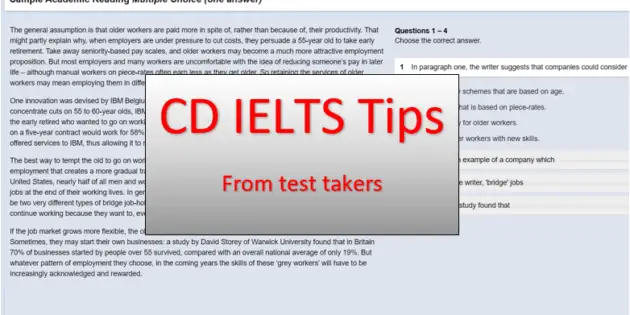The computer delivered IELTS test follows the exact same format and timings that the paper based IELTS test does. The tips below are based mainly on what has worked for past students of mine and might help you to:
#1 – Adjust text size and background colour
Make your eyes comfortable by changing the size of the text and the background colour. You are going to be looking at your screen for a longtime and it can reduce the strain on the eyes making it easier to focus.
#2 – Use the highlighter function
A great advantage of the computer based IELTS is the fact that you are able to highlight sections of text to help you focus on where you think the answer is, or which part you might need to refer back to later. Simply right click and select highlight on the text you require highlighting.
#3 – Leave your headphones on
As soon as you get a set of headphones, put them on. Of course, you will need them for the listening test, which often comes first, but if you leave them on they will block any distracting noises coming from other candidates.
Having a room full of candidates all typing furiously on keyboards can be surprisingly noisy and distracting, definitely not what you need! By leaving your headphones on you get to sit in your own little focused world which can help you to remain calm throughout the test.
#4 – Don’t use the CTRL and F shortcut
Sadly, you cannot use this function to ‘find’ certain words in texts. This would give the computer delivered test an option to candidates that paper based users do not have and so can’t be allowed, that said being able to highlight is allowed on computer but you can’t actually take highlighter into an IELTS paper based test which I find weird.
On the same note, copy and paste does not work either in the listening and reading tests, but it does work in the writing test which is helpful when editing your work.
My full course gives lots of reading strategies here.
#5 – Use the pencil and paper you are given
You can still make notes using pencil and paper as you do the test and I recommend that you plan your essay on paper first as this seems to enable faster and clearer planning. However, the paper you are given is replaced after each section of the test: reading, writing and listening. This means that you can’t make any notes and keep them for later in the test.
#6 – Save time by moving forward early
You can move forward earlier through the listening section of the test if you are ready to. So, if you are good at listening and finish all the questions and don’t need to check anything then you can go forward to the next questions early.
You can then read those questions and predict what the answers might be so that you are ‘super ready’ for when that section of audio is played.
Furthermore, you can go back at any time and check any answers during that section of the test. You cannot jump back from the writing to the reading section though only within the same section.
#7 – Spend longer planning and proofreading
Due to the fact that you will be able to edit and rewrite your sentences much faster on computer than if you were crossing out your work and rewriting sentences in the paper based test, experience from my students suggests that you will gain 3-5 minutes in time overall for the essay section.
And that is not taking into account any time you usually spend counting the number of words you have written as well as the computer will do this for you too!
I suggest that you spend this ‘extra’ time really planning your essay a bit more carefully so that you do not make any of the typical mistakes such as going off topic.
Any extra time at the end should be spent checking your work. Remember, by simply going back and correcting typos and basic grammar and punctuation you can increase your band score in those last few minutes!
#8 – Click on the clock to get the seconds
Whilst doing computer based IELTS you will have a clock counting your time down for you. Be aware that in the last minute the number disappears and does not give you a 60 second countdown unless you click on the time, in which case you can get the 60 second countdown.
#9 – Do not risk leaving any changes until the end
Be warned that your computer will immediately freeze that section at the end of the countdown unlike when you do paper based when you might be able to squeeze an extra second or two before you put your pencil down – there is no chance of doing this in computer based IELTS so make your changes early!
#10 – Do not write in capitals in listening and reading
When doing paper based IELTS some teachers recommend that you write your listening and reading test answers in all capitals so as to make your handwriting clear which is not a bad idea. However, in computer-delivered IELTS, handwriting is not going to be a problem so you should type using upper and lowercase letters as this is more appropriate.
If you are not sure which letters should be upper or lower case then often you can copy how those words have been capitalised in the reading passages or questions.
#11 – Do not write in capitals for your essay
According to IELTS, errors with capitalisation are classified as punctuation issues and so if you write all in capitals it will damage your grammar score. In reality, native speakers rarely, if ever, write an essay in capitals and so you should not either.
#12 – Practise listening and typing
You might be used to listening and writing with a pencil as you need to do in paper based IELTS but listening and typing is significantly different, especially if you are not already a good typist.
The problem is that you not only have to listen but you have to look down and potentially search for keys to press, whereas, if you are writing there is nothing to search for, writing is a more automatic process so don’t get caught out by this difference, practise beforehand, and consider paper based IELTS if this is too difficult for you.
#13 – Expect new question types
Well, actually the question types are exactly the same as in paper based IELTS but the way you answer is different, and easier. For example, instead of having to write TRUE/FALSE/NOT GIVEN you simply click your chosen option from a list, dead easy.
Similarly, for matching heading question types all you need to do is drag and drop the headline above the paragraph. Information matching questions take the form of a grid and you simply tick the boxes to match information to paragraphs.
I strongly recommend though, that you go through the free training provided here: IDP practise test so that you know and are familiar with everything to do with the computer delivered version of the test.
#14 – Use the tab key to move on
Although you can’t skip from the reading questions to the writing questions, you can skip through the questions within the same section as quickly as you like using the tab key.
It sounds obvious, but I have known candidates be unable to work this out and it really stressed them out as they lost time trying to figure out how to navigate through the questions. Now, it won’t be you!
#15 – Use the shift and tab to skip back
Checking your answers is key in IELTS and so using this keyboard shortcut is going to make this easy for you to do.
#16 – Get used to scrolling through long articles
Nowadays, a lot of people have become used to flicking through social media posts and pictures without ever stopping to really focus on something for a length of time, or to really get to grips with a difficult topic through a long article on a computer screen.
Do not wait until the IELTS CD test to do this, otherwise you might find it more challenging and tiring than it should be. Remember, working in a second language is more tiring than your own language and so this is something you need to get used to, or risk struggling on test day.
#17 – Be familiar with the local keyboard layout
Around the world there are slight variations in where certain keys are placed. It would be very dispiriting to sit down at your computer and realise that you were not familiar with where some of the keys are. Imagine how much more difficult the listening test would suddenly become.
So, especially if you are flying to a different country to take your test from, phone the test centre and ask them what style of keyboard layout they are using. You can then do a bit of googling and find out what/if any differences there are and avoid a panic on test day!
#18 – Use CTRL and C/V in your essay task
These keyboard shortcuts do work in this part of the test and can be very useful for editing your work. Whether you want to move a sentence somewhere else or just copy and paste an individual word you can do so, all the precious seconds you save can be used for checking your work later.
How to prepare for computer based IELTS
To compare for computer based IELTS make sure you take the IDP sample computer based test so you are familiar with how to navigate through the questions and sections, and how to do the question types in the computer layout. You also need to have practised listening and typing at the same time.
You can access the practise test here: IDP practise test, British Council practise test, or Cambridge English practise test.
And of course you will still need to be preapred with test strategies in all the usual ways, you might want to read my IELTS writing task 2 guide, IELTS academic writing guide at this point.
Is computer delivered IELTS easy?
Computer Delivered IELTS is considered easier than paper based if you are competent at typing on a keyboard and if you are able to listen and type simultaneously. The main advantage is that in the writing section you can edit your work much more easily than if you were writing your work hence saving you time.
Recommended IELTS Study Tools
Thank you for reading this article. I always get lots of questions about how else to get a better band score quickly. So, this is what I recommend:
Complete IELTS Course: Of course, my full course ‘INCREASE YOUR IELTS‘ covers everything you need to need to know to pass IELTS, including practice questions, model answers, grammar work, strategies for every possible reading, writing and listening question type, as well as a complete speaking course too, check it out here.
IELTS Essay and Speaking Feedback: To complete full mock tests and get feedback from IELTS examiners on your IELTS essays or speaking tasks then visit: IELTS Feedback and Mock Tests, here.
Improve your grammar fast by using the Grammarly suggestions to improve your writing. Every IELTS students should have this free grammar improving tool.
Improve all-round English skill with EnglishClass101.com. If you have failed IELTS more than once then you probably need to improve your general level of English. Use the free online lessons and vocabulary building tools here and start improving today! HIGHLY RECOMMENDED!





